Burlington Coat Factory Bundle
Who Shops at Burlington Coat Factory?
In the ever-evolving world of retail, understanding customer demographics and the target market is crucial, especially for a value-driven giant like Burlington Stores. From its humble beginnings in 1972 selling coats, Burlington has transformed into a retail powerhouse, offering a diverse range of products at attractive discounts. This strategic shift has positioned Burlington to capitalize on the growing demand for affordable, branded goods.
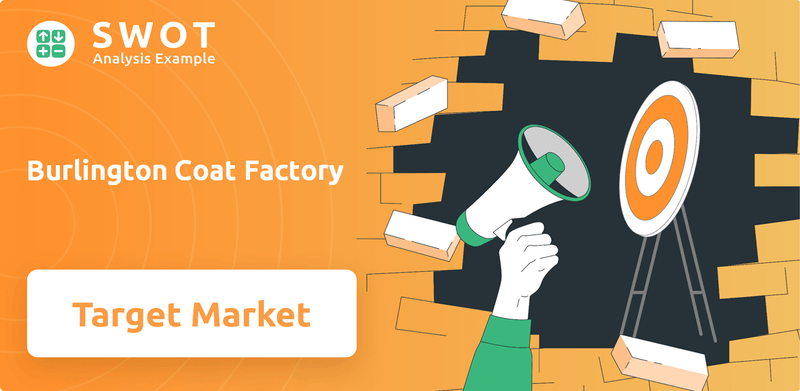
The off-price retail sector is booming, and Burlington Coat Factory SWOT Analysis reveals how the company is strategically positioned to thrive in this environment. With net sales exceeding $10 billion in fiscal year 2024 and ambitious expansion plans, understanding the Burlington demographics and its target market is key. This analysis delves into the customer profile, exploring factors like customer age range, income levels, location, and buying habits to uncover the secrets behind Burlington's success in the discount retail landscape.
Who Are Burlington Coat Factory’s Main Customers?
Understanding the customer demographics and target market of the company is crucial for its success. The primary focus is on the Business-to-Consumer (B2C) market. This approach allows the company to tailor its strategies to effectively reach and engage its core customer base.
The primary customer segment for the company is typically identified as women aged 25-49. This group often lives in mid- to large-sized metropolitan areas. They are brand-conscious and enjoy fashion, shopping for themselves, their families, and their homes. This demographic is a key driver of the company's sales and marketing efforts.
The company caters to value-seeking, fashion-conscious customers who are price-driven. It offers branded merchandise at discounted prices, attracting a broad consumer base. This strategy is particularly relevant, as over 70% of global consumers prioritize affordability when shopping.
The core customer is a woman aged 25-49. She is typically educated and lives in a metropolitan area. She is brand-conscious and seeks value.
Customers shop for themselves, their families, and their homes. They are price-driven but appreciate style and quality. They seek branded merchandise at discounted prices.
The company offers a wide range of products beyond coats and outerwear. These include women's and men's apparel, youth apparel, baby items, and home goods. This diversification caters to diverse needs.
The company aligns with the trend of value-for-money shopping. The off-price retail sector is successful, with over 70% of global consumers seeking value. This supports the company's strategic direction.
Historically, the company has expanded its product categories to meet diverse customer needs. This includes women's and men's apparel, youth apparel, baby items, and home goods. This diversification reflects its ongoing adaptation to serve a broader target market, ensuring it remains relevant in the dynamic retail landscape. This expansion is crucial for attracting a wider range of customers and maintaining its competitive edge. The company's ability to offer a variety of products helps it appeal to a broad customer base, enhancing its market position.
The company's target market is primarily women aged 25-49, who are brand-conscious and value-driven. They seek quality merchandise at discounted prices. The company's success aligns with the growing consumer preference for value.
- Customer demographics include a focus on the 25-49 age group.
- The target market is brand-conscious and seeks value.
- The company's strategy aligns with the global trend of value-for-money shopping.
- The company has expanded its product range to cater to a broader audience.
Burlington Coat Factory SWOT Analysis
- Complete SWOT Breakdown
- Fully Customizable
- Editable in Excel & Word
- Professional Formatting
- Investor-Ready Format
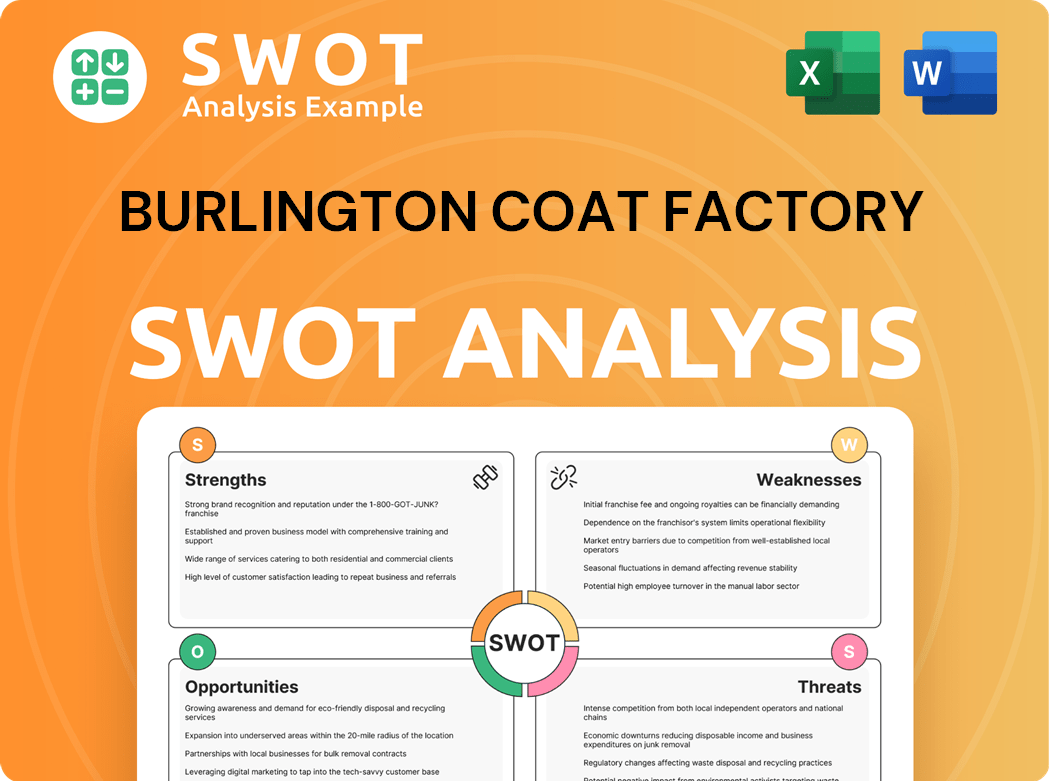
What Do Burlington Coat Factory’s Customers Want?
Customer needs and preferences at Burlington are centered around value and quality, especially for branded merchandise. Consumers are increasingly looking for affordability without sacrificing brand recognition or product quality. This is a key driver in the off-price retail sector.
Burlington meets these needs by offering in-season, fashion-focused merchandise at prices significantly below those of other retailers. The company's strategy is built on providing a 'treasure hunt' shopping experience, where customers enjoy finding deals on branded goods. This experiential aspect is a key factor in customer loyalty.
The company's business model is tailored to meet the needs of price-conscious consumers by strategically sourcing merchandise and managing inventory efficiently. This approach ensures a diverse selection of well-known brands, which is a key factor in attracting customers.
Approximately 70% of consumers in the off-price retail market prioritize affordability. This highlights the importance of Burlington's value proposition. The focus on offering discounts of up to 60% off other retailers' prices directly addresses this need.
About 60% of consumers in the off-price market prefer premium brands at discounted prices. Burlington caters to this preference by stocking a diverse selection of well-known brands. This strategy aligns with the demand for quality and brand recognition.
The 'treasure hunt' experience is a significant factor in customer loyalty. The excitement of finding unique items at discounted prices motivates customers. This experiential aspect differentiates Burlington from other retailers.
Offline sales still dominate the off-price retail market, contributing 70% of total revenue. Burlington's brick-and-mortar strategy aligns with customer preferences for in-store shopping. Customers prefer to see, touch, and try on merchandise before purchasing.
Burlington's merchandise sourcing strategy involves purchasing excess inventory, canceled orders, and end-of-season merchandise. This allows the company to offer significant savings to price-conscious consumers. This approach is a key element of the business model.
The increasing demand for discounted branded goods has influenced Burlington's continued focus on its off-price model and store expansion. This demonstrates the company's responsiveness to market trends and customer preferences. This is discussed in detail in the article about Owners & Shareholders of Burlington Coat Factory.
Understanding the customer demographics and the Burlington Coat Factory target market is crucial for success. The company's focus on value, quality, and the in-store experience reflects a deep understanding of its customers.
- Value for Money: Customers seek the best possible prices on branded merchandise.
- Brand Recognition: Preference for well-known brands at discounted prices is high.
- In-Store Experience: Customers enjoy the 'treasure hunt' and prefer to shop in physical stores.
- Fashion-Focused Merchandise: Demand for in-season, stylish items is a priority.
Burlington Coat Factory PESTLE Analysis
- Covers All 6 PESTLE Categories
- No Research Needed – Save Hours of Work
- Built by Experts, Trusted by Consultants
- Instant Download, Ready to Use
- 100% Editable, Fully Customizable
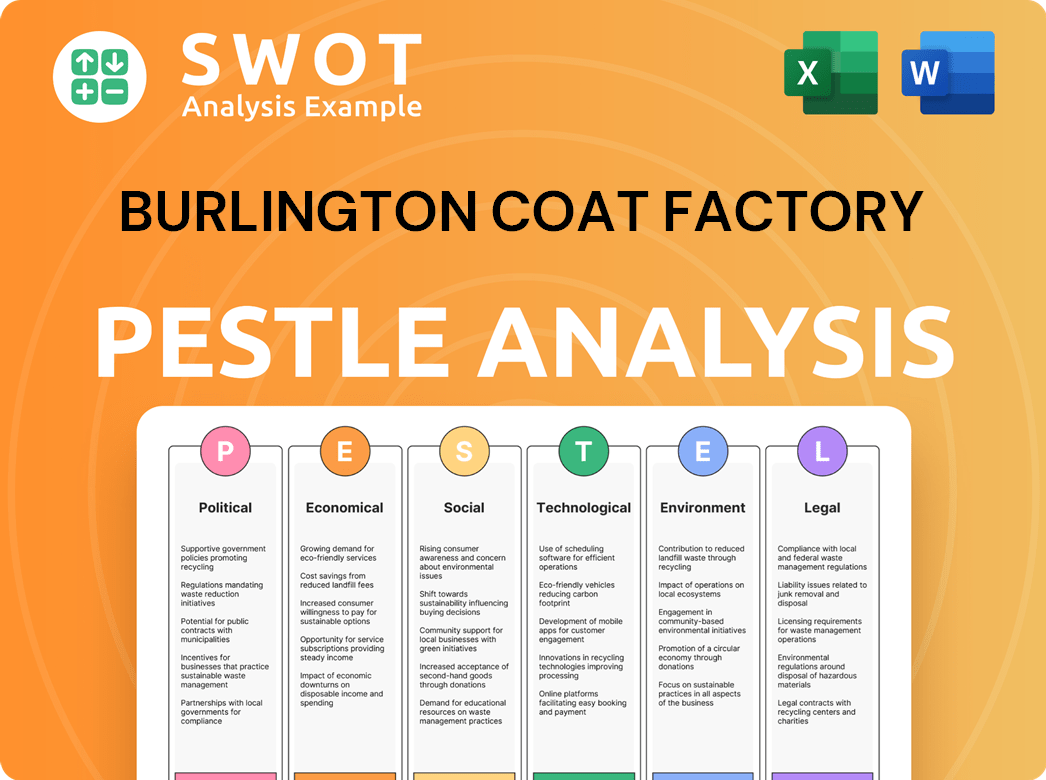
Where does Burlington Coat Factory operate?
The geographical market presence of Burlington Stores is extensive, primarily concentrated within the United States. As of the end of the first quarter of fiscal 2025, the company operated a vast network of 1,115 stores across 46 states, Washington D.C., and Puerto Rico. This widespread distribution highlights its established position as a prominent off-price retailer, making it accessible to a broad customer base.
North America, particularly the U.S., significantly dominates the global off-price retail market. In 2024, the U.S. held a 54% share, valued at $132.7 billion. This dominance is fueled by mature off-price retail chains with expansive store networks. This includes the company, which contributes to this market share with its widespread store coverage. For instance, Philadelphia alone has 39 stores.
The company is strategically expanding its footprint, targeting underserved markets, including urban downtowns. The company opened 101 net new stores in 2024 and plans to open approximately 100 net new stores in fiscal year 2025. This expansion is a key part of the company's growth strategy, intending to increase its market presence and reach more customers. The company aims for a long-term target of 2,000 stores, demonstrating a commitment to sustained growth and market penetration. To learn more about the company's origins, check out this Brief History of Burlington Coat Factory.
The company is actively expanding into underserved markets, including urban downtowns. This strategic move aims to capture a broader customer base by locating stores in areas with high foot traffic and demand.
Since 2017, the company has been downsizing the square footage of its new stores to approximately 20,000 square feet. This approach allows for greater flexibility in site selection and cost-efficiency.
In May and June 2025, the company acquired 45 expiring Joann Fabrics store leases in states like California and Texas. This strategic move accelerates its expansion plans and strengthens its presence in key markets.
The company opened 101 net new stores in 2024 and plans to open approximately 100 net new stores in fiscal year 2025. The majority of these openings are expected to occur in the latter half of the year.
The company's expansion strategy aims to increase its market presence and reach more customers. The long-term target is to operate 2,000 stores, indicating a strong focus on growth.
While sales data in Q1 2025 showed a broad slowdown across 'trade areas with different demographic characteristics,' it is too early to attribute this to a broader pullback in consumer spending.
Burlington Coat Factory Business Model Canvas
- Complete 9-Block Business Model Canvas
- Effortlessly Communicate Your Business Strategy
- Investor-Ready BMC Format
- 100% Editable and Customizable
- Clear and Structured Layout
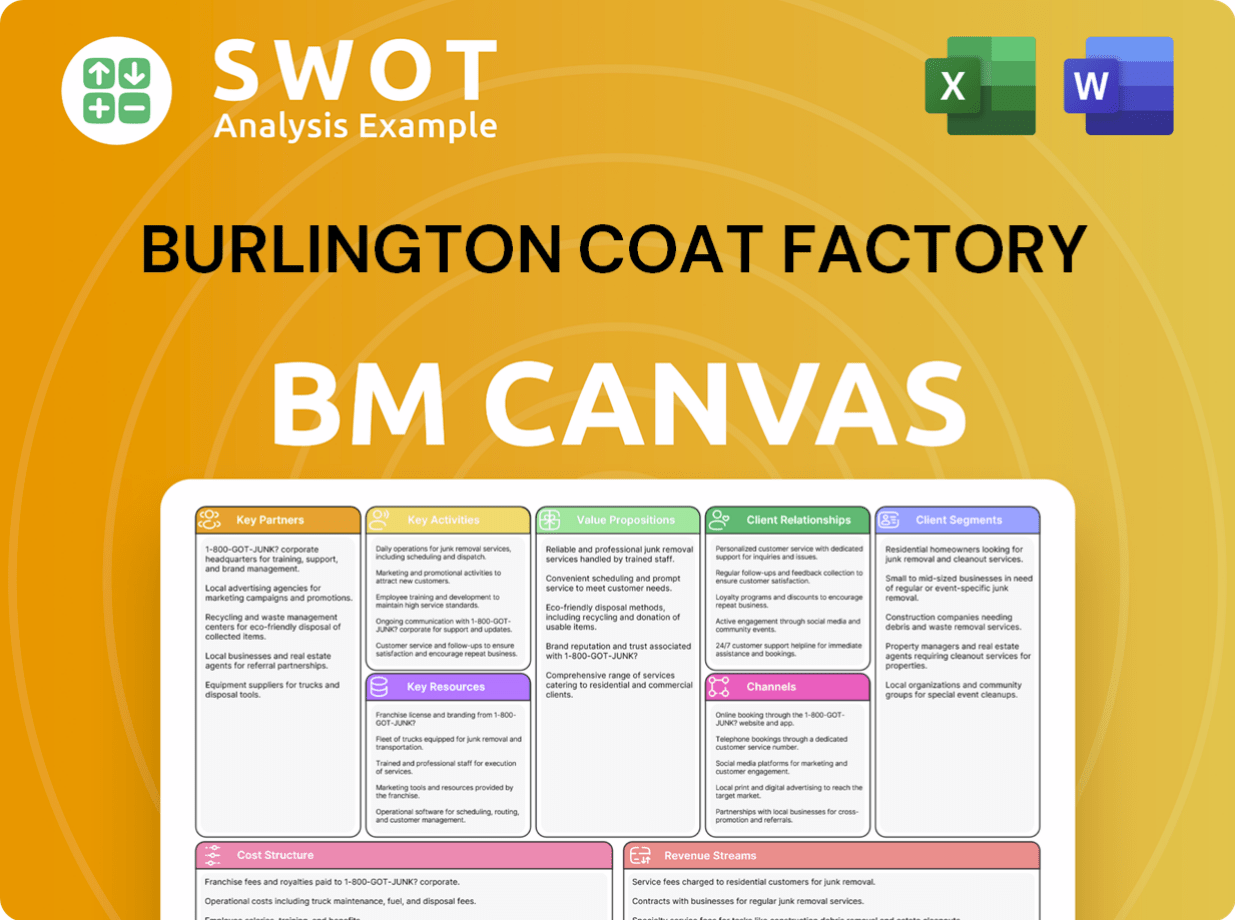
How Does Burlington Coat Factory Win & Keep Customers?
Burlington Stores' customer acquisition and retention strategies are primarily centered around its off-price retail model. This approach focuses on providing high-quality, branded merchandise at significantly discounted prices. This value proposition is a key driver for attracting customers, particularly those who are value-conscious and looking for deals, especially during fluctuating economic conditions. The company's strategy emphasizes offering merchandise at prices often up to 60% off other retailers.
The company leverages its in-store 'treasure hunt' experience as a critical element of its customer retention strategy. This approach encourages repeat visits as shoppers seek out new deals and discover unique items. While specific details on digital marketing or loyalty programs are not extensively disclosed, the company focuses on a physical store presence, with a constant rotation of inventory to keep the shopping experience fresh and engaging. This strategy is designed to maintain customer interest and drive repeat business.
Burlington's marketing efforts utilize a variety of broad channels to reach its target audience. Although specific details on digital, traditional, social media, influencer, and referral marketing channels are not extensively disclosed, the company communicates material information through SEC filings, press releases, public conference calls, and webcasts. They also use their website and social media platforms like Facebook and X (formerly Twitter) for updates on new brands, services, and marketing campaigns. This approach aims to keep the customer informed and engaged, driving both acquisition and retention.
The company's ongoing store expansion strategy is a key element of its customer acquisition plan. Burlington opened 101 net new stores in 2024 and plans to open approximately 100 net new stores in 2025. This physical expansion, including smaller store prototypes in high-traffic areas and expansion into underserved urban downtowns, aims to increase market presence and accessibility, thereby driving incremental sales and fostering customer loyalty through increased convenience.
The core of Burlington’s strategy is its value-driven approach. By offering branded merchandise at significantly discounted prices, the company attracts a broad customer base. This strategy is particularly effective in attracting value-conscious consumers who are always looking for deals. This approach is a primary driver for customer acquisition, particularly appealing to value-conscious consumers in fluctuating economic conditions.
The 'treasure hunt' aspect of the in-store experience is a crucial retention strategy. The constantly rotating inventory and the excitement of finding new deals encourage repeat visits. This unique shopping experience is a key differentiator for Burlington, driving customer loyalty and engagement. This element of discovery keeps customers coming back for more.
Strategic initiatives, such as 'Burlington 2.0,' focus on enhancing operational efficiencies. These improvements, along with the ability to quickly adapt merchandise and pricing to consumer spending trends, contribute to better customer experiences and increased retention. These efforts indirectly contribute to customer retention and satisfaction.
Burlington's ability to adapt its merchandise assortment and pricing quickly to consumer spending trends is also vital for maintaining customer engagement. The company's focus on its physical stores, with no e-commerce presence, emphasizes the in-store shopping experience. This strategy is further detailed in the Competitors Landscape of Burlington Coat Factory.
Burlington Coat Factory Porter's Five Forces Analysis
- Covers All 5 Competitive Forces in Detail
- Structured for Consultants, Students, and Founders
- 100% Editable in Microsoft Word & Excel
- Instant Digital Download – Use Immediately
- Compatible with Mac & PC – Fully Unlocked
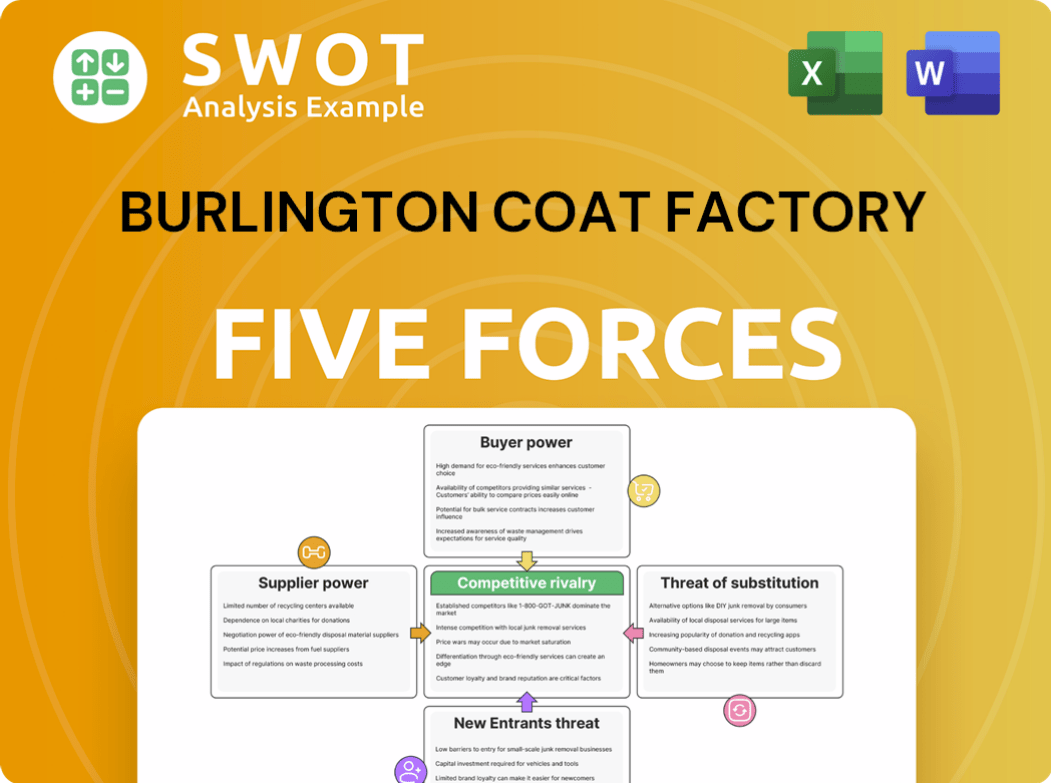
Related Blogs
- What are Mission Vision & Core Values of Burlington Coat Factory Company?
- What is Competitive Landscape of Burlington Coat Factory Company?
- What is Growth Strategy and Future Prospects of Burlington Coat Factory Company?
- How Does Burlington Coat Factory Company Work?
- What is Sales and Marketing Strategy of Burlington Coat Factory Company?
- What is Brief History of Burlington Coat Factory Company?
- Who Owns Burlington Coat Factory Company?
Disclaimer
All information, articles, and product details provided on this website are for general informational and educational purposes only. We do not claim any ownership over, nor do we intend to infringe upon, any trademarks, copyrights, logos, brand names, or other intellectual property mentioned or depicted on this site. Such intellectual property remains the property of its respective owners, and any references here are made solely for identification or informational purposes, without implying any affiliation, endorsement, or partnership.
We make no representations or warranties, express or implied, regarding the accuracy, completeness, or suitability of any content or products presented. Nothing on this website should be construed as legal, tax, investment, financial, medical, or other professional advice. In addition, no part of this site—including articles or product references—constitutes a solicitation, recommendation, endorsement, advertisement, or offer to buy or sell any securities, franchises, or other financial instruments, particularly in jurisdictions where such activity would be unlawful.
All content is of a general nature and may not address the specific circumstances of any individual or entity. It is not a substitute for professional advice or services. Any actions you take based on the information provided here are strictly at your own risk. You accept full responsibility for any decisions or outcomes arising from your use of this website and agree to release us from any liability in connection with your use of, or reliance upon, the content or products found herein.